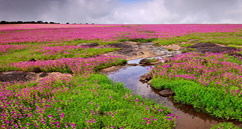Kaas Pathar
The Kaas Plateau also known as the "Kaas Pathar" which is situated in the Western Ghat Sahyadri range, 22 kilometers from Satara city in Maharashtra state of India. The name Kaas originates from Kaasa tree (Elaeocarpus glandulosus). Leaves of this tree turn green to red as they mature. It gets white flowers only for 15 days in the month of March. The area of plateau is approximately 1,000 hectare.
The plateau is full of wild flowers during the months of August and September. These flowers bloom on their own and stay for about 2–3 weeks (depending on the monsoon and other weather factors). Recently it has been declared as Biodiversity World Heritage Site by The United Nations Educational Scientific and Cultural Organization (Unesco). It has an small lake nearby, so when you are driving down the curves from Kaas Plateau you see a sign on left saying - Kaas Talav. It is a natural tranquil. Kaas lake is surrounded by dense forests. To the left of the lake lies Sajjangad fort and the Kanher Dam lies to the right. It is a famous picnic spot with the locals. The place has more than 850 different species of flowers and other plants including Orchids, Karvy and carnivorous plants such as Drosera Indica. This falls under the Sahyadri Sub Cluster ofWestern Ghats which is now a UNESCO World Heritage Site. To visit Kaas plateau, register on the website www.kas.ind.in
About
Kaas plateau is a plateau located near Satara. It is situated high hill plateaus and grasslands turns into a 'valley of flowers' during monsoon season, in the month of August. Kaas Plateau has more than 150 or more types of flowers, shrubs and grasses. The orchids bloom here for a period of 3–4 weeks during this season. Kaas plateau a World Natural Heritage site. For registration to visit Kaas platoon visit athttp://www.kas.ind.in/
Geography
Kaas plateau is a plateau located around 25 km from Satara. There are two ways to reach Kas. one the more direct way from Satara and another from Tapola via the link road connecting Mahabaleshwar and Panchgani to Kas Pathar. The link road facilitates tourists in staying in Tapola or Mahabaleshwar after visiting Kas Pathar rather than the Satara town or cutting the weekend picnic short and making it a one day weekend picnic. Kas plateau is 20 km away from Northern part of Koyana Sanctuary. The major portion of the plateau is reserve Forest. Kaas lake (built 100 years ago) is a perennial source of Water supply for western part of Satara city by gravity. The flora of Kaas are around the locality of that area. The plateau is largely formed of basalt which is directly exposed to atmosphere. The basalt rock is covered by a thin cover of soil formed due to erosion and has accumulated a layer of not more than an inch or so. This soil is neither black nor lateritic. At certain places water gets accumulated because of uneven surface. The plants growing on Kas plateau are typically of herbaceous nature of like grasses. The small shrubs and trees are located at the periphery of the plateau at Kaas plateau.
The various distances of Kas palteau are as follows:
From Satara - 25 km
From Pune - 125 km
From Mumbai - 280 km
Flowers
The following is a list of some of the flowers found on this plateau.
Ceropegia Vincaefolia (local name Kandilpushpa)
Ceropegia Jainii (local name Somada)
Drosera Indica (local name Gavati Davbindu)
Smithia hirsute / hirsuta (local name Kavala)
Senecio grahami / bombayensis (Sonakee)
Utricularia purpurascens (Seetechee aasawe)
Senecio bombyensis (local name Sonki)
Murdannia lanuginosa (local name Abolima)
Pogostemon deccanensis(
Dipcadi montanum (Deepkadee)
Impatiens oppositifolia
Wild Brinjal flower
Aponogeton satarensis (local name Vaytura)
Elaeocarpus glandulosus (local name Kaasa)
Pinda concanensis (local name Pinda)
Hitchenia caulina (local name Chavar)
Paracaryopsis coelestina (local name Nisurdi)
Nymphoides indicum (local name Kumudini)
Cyanotis tuberosa (local name Abhali)
Murdannia simplex (local name Nilima)
Paracaryopsis malbarica (local name Kali Nisurdi)
Begonia crenata
Trichosanthes tricuspidata (local name Kondal)
Chlorophytum glaucoides (local name Musali)
Ipomoea barlerioides
Ceropegia media
Drosera burmanni (local name Davbindu)
Habenaria longicorniculata
Aerids maculosum
Dendrobium barbatulum (Bharangee)
Habenaria panchagnesis
Memecylon umbellatum (local name Anjani)
Habenaria heyneana (local name toothbrush Orchid)
Habenaria grandifloriformis
Smithia agharkarii
Flemingia nilgheriensis
Rotala ritchiei (local name Paner)
Rotala fimbriata
Adenoon indicum (local name mothi sonaki)
Linum mysurense (local name Undri)
Dioscorea bulbifera (local name dukkar kanda)
Vigna vexillata (local name Halunda)
Oberonia recurva
Arisaema murrayi (local name Pandhara Sapkanda)
Exacum tetragonum (local name Udi chirayat)
